Bulletin – May 2003 Credit Risk Transfer Markets: An Australian Perspective[1]
- Download 79KB
Introduction
For banks, and other authorised deposit-taking institutions (ADIs), one of the most significant challenges in the management of their day-to-day business is the monitoring and control of credit risk – the risk of financial loss arising from the failure of a customer to repay principal or interest. Credit risk is primarily contained by carefully assessing the credit standing of individual customers and by limiting exposures both to them and to groups of customers vulnerable to the same shocks. When these limits are reached, a prudent ADI will decline new business or take steps to reduce some of its existing commitments.
In recent years, the management of credit risk has been enhanced by the growth of financial markets for hedging or selling credit exposures – a development that is helping to redistribute credit risk away from ADIs to financial intermediaries such as managed funds. This article highlights some recent developments in these credit risk transfer (CRT) markets and notes some of the longer-run implications for the Australian financial system. Among ADIs, the emphasis is on banks, since they account for the vast bulk of credit risk originated within the financial sector.
Credit Risk Transfer Markets
Techniques for transferring credit risk are not new. The practice of syndicating, or sharing large loan facilities among banks was already commonplace in the United States by the 1970s and within a decade an active secondary market for bank loans had also emerged. The packaging and sale of loan portfolios was piloted in the United States over the same period beginning with residential mortgages. In a process known as securitisation, mortgages are sold by the originating financial institution to a specially created company or trust – usually referred to as a special-purpose vehicle (SPV) – which finances the purchase by issuing securities to investors, using the home loans as collateral.
Subsequently, securitisation has been used in the United States and elsewhere to create a wide range of asset-backed securities including for commercial property, trade and credit card receivables, and car loans. Collateralised debt obligations (CDOs) are similar to asset-backed securities, but with the securitisation techniques applied to larger, less homogenous assets, typically corporate bonds or loans. The end result is the same: credit risk is removed from the originating institutions and dispersed via the capital markets in the form of risk-bearing securities. These securities are usually issued in several different tranches to provide investors with a selection of risk/return options – a process that requires a credit rating agency to provide an external assessment of the quality of the underlying asset pool.
In the late 1990s, the trading of credit risk underwent a step change with the emergence of credit derivatives. In essence, credit derivatives are just one more stage in the evolution of modern financial markets as new technology combines with advances in financial mathematics to facilitate the breaking-down of financial claims into their constituent risk elements (credit, interest rate, foreign exchange, etc), with each traded separately in standardised wholesale markets. In the case of credit derivatives, the standardised instrument is the credit default swap (CDS) – a contract in which one counterparty (known as the ‘protection seller’) agrees to compensate another counterparty (the ‘protection buyer’) if there is a credit event, such as bankruptcy, which indicates that a specified company or sovereign (the ‘reference entity’) may be unable to service its debts.
One of the characteristics of credit derivatives is that they transfer credit risk without the sale or transfer of any underlying assets. When this characteristic is combined with securitisation techniques, credit derivatives facilitate a process known as ‘synthetic’ securitisation in which the credit risk associated with a pool of assets – rather than the assets themselves – is assembled in an SPV. This avoids the costs and complexities of transferring assets. (See Appendix for some details on securitisation structures.)
Credit derivatives are also very flexible. By using CDS, banks can build up pools of credit risk that may, or may not, originate on their own balance sheet. This allows them to tailor portfolios more closely to the preferences of investors. They can also be used to structure credit-linked notes (CLNs). These are securities, issued directly to investors, on which future repayments are linked to credit events involving one or more reference entities. If a credit event occurs, payments of interest and/or principal will be reduced.
Although the range and complexity of CRT instruments has multiplied in recent years, they can still be classified according to a relatively small number of key features. One distinction is whether they transfer the credit risk of an individual company or sovereign (single name) or a number of them (portfolio). Another relates to funding. The sale of a loan in the secondary market, for example, is a funded risk transfer – by selling the loan, a bank extinguishes the associated credit risk and receives an upfront payment. Similarly, traditional securitisation structures, such as asset-backed securities, involve the sale of the underlying assets and an associated funds inflow. As noted above, however, this is not true of a CDS transaction, nor of a synthetic securitisation, both of which facilitate a reduction in credit risk without any sale of the underlying assets; as a result there is no funds inflow to the originating institution.
The choice of CRT instruments and markets will depend on the motivation of participants. All instruments reduce the amount of credit risk on the balance sheet of the originating institution and, hence, the amount of regulatory and economic capital to be held against it. (An important proviso in the case of regulatory capital is that the financial regulators are satisfied that the transfer of credit risk is fully effective and final – that there can be no recourse to the originating institution in the event of default). But if the objective is both to reduce credit risk and obtain financing then only funded instruments will be selected.
Australian credit risk transfer markets
The CRT markets in Australia have evolved in a broadly similar fashion to those in the United States and other developed countries. Australia has a small but active syndicated loan market, for example, with 79 syndications totalling $37.2 billion arranged in 2002. There is, however, very little in the way of secondary loan trading – seemingly reflecting the small scale of these syndications relative to those in international markets – so that participating banks have little interest in off-loading any further slice of their share. On a relationship level, there also appears to be some reluctance among lenders to risk giving offence to corporates by openly selling their credits.
In contrast to the sluggish trading of individual loans, Australian banks have embraced the packaging and sale of credit risk in securitised form, particularly for residential mortgage lending. The Australian market for residential mortgage-backed securities (RMBS) emerged in the mid 1980s to assist state governments with the financing of public sector housing schemes. After a period in the doldrums, the RMBS market expanded rapidly from the mid 1990s facilitated by, and contributing to, buoyant housing market conditions. This success, in turn, spurred the packaging of a wide range of other assets, including holdings of securities. The packaging of securities – often as asset-backed commercial paper issues – is usually undertaken to exploit arbitrage opportunities existing in the market. As at end December 2002, asset-backed securities outstandings (including asset-backed commercial paper and offshore issues) were over $100 billion, of which mortgage-backed securities accounted for almost 70 per cent of the underlying assets and repackaged securities a further 20 per cent (Graph 1).
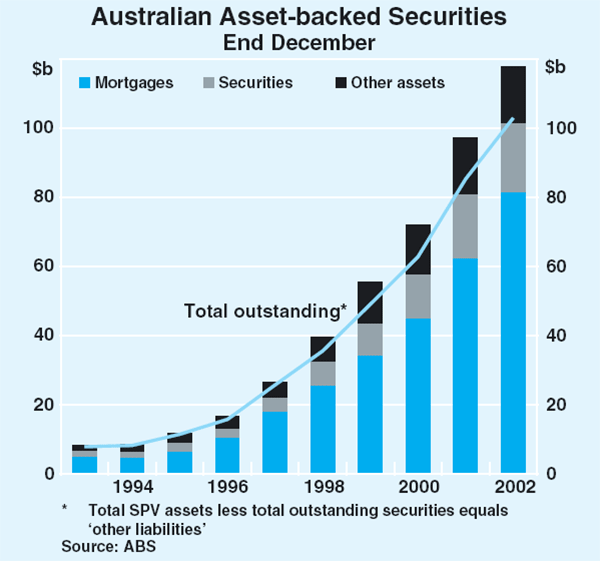
The first Australian CDO appeared in December 1997, but in contrast to the asset-backed securities market, the securitisation of corporate loans has been sporadic. An early obstacle was loan documentation that precluded the reassignment of loans without the consent of borrowers. But even where transferability exists – and this characteristic is being progressively built into Australian loan documentation – banks may still be reluctant to enforce it and jeopardise relationships with clients.
With synthetic transactions, these concerns about transferability are addressed through the use of CDS. In Australia, there are publicly quoted CDS prices for 30 companies, and the Australian Financial Markets Association (AFMA) estimates that CDS outstanding in the local market amounted to $20 billion as at June 2002.
The tepid embrace of CDOs, even in synthetic form, seems to reflect a number of concerns. At the global level, the deteriorating credit environment and the poor performance of issues containing ‘fallen angels’ – investment-grade names that are subsequently downgraded or default – has made investors increasingly wary of CDOs, particularly of the higher-risk tranches. And without a ready buyer for the ‘equity’ or first-loss tranche, banks may need to retain this high-risk slice on their own books – which reduces the regulatory capital relief that would otherwise attach to the transaction and, as a result, jeopardises the pricing of the issue.
A more parochial problem is the relatively small number of rated companies in Australia. From a supply perspective, this makes it difficult to put together a pool of Australian credits that will support the issue of investment-grade securities. And rather than diversify to lower-quality securities – which investment mandates may tightly prescribe against – Australian fund managers prefer to invest offshore in global debt markets. The challenge for banks is to encourage these managers to invest a small amount of their portfolio in unrated or privately placed issues, helping the banks to ‘unlock’ a wider slice of the credit risk on their balance sheets.
Implications for the Role of Banks
The development of CRT markets has important implications for the role of banks in the financial system. Traditionally, banks have adopted an ‘originate and hold’ approach to credit risk, retaining corporate and retail customer loans on their books until fully repaid. So at one level, the attraction of CRT instruments lies in the tools they provide banks for more effectively controlling credit risk: credit default swaps can be used to ‘buy protection’ to hedge concentrated loan exposures; and the purchase of asset-backed securities allows banks to acquire exposures that they can't easily originate themselves. For example, a regionally based bank can diversify its balance sheet nationally or globally by purchasing a CDO containing credit exposures to customers with whom it has no banking relationship. Importantly, CRT markets also allow banks to manage their economic and regulatory capital requirements. Rather than decline new business opportunities when capital becomes a constraint, a bank can choose to buy protection on or securitise parts of its existing lending book.
But at another level, CRT markets also provide a means by which banks can respond to the structural change underway in many developed financial systems as a growing proportion of household financial assets is channelled towards institutional investors such as managed funds. This shift partly reflects the growing sophistication of the household sector, which increasingly searches beyond the banking sector for higher returns. But there are also some important demographic factors at work reflecting the ageing of the population in many developed countries and the need for expanded retirement savings schemes. In Australia, for example, the introduction of compulsory employer superannuation contributions has been an important factor behind the growth in funds under management over the past decade (Graph 2).
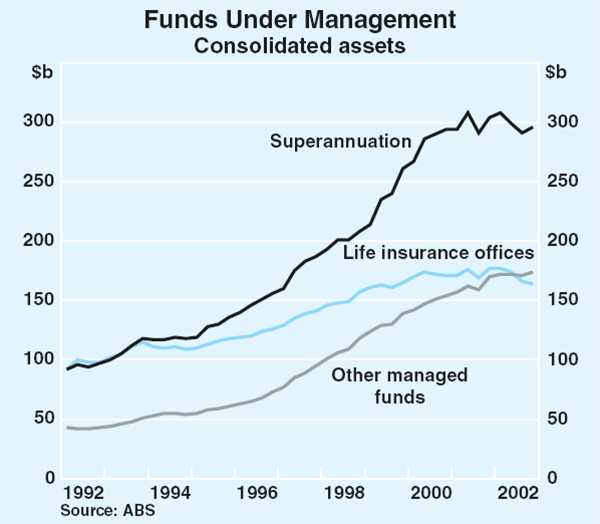
The expansion of the managed funds sector has fuelled strong demand for equities, both domestic and foreign. However, capital preservation is also important to many investors in managed funds, particularly retirees and employees approaching retirement who prefer stable, rather than high but volatile returns. (This preference has assumed wider investor appeal as the impact of falling equity markets on funds' performance has unfolded.) As a result, managed funds also need a good supply of suitably rated securities. In Australia, however, this demand has coincided with a decline in the size of the Government bond market (Graph 3).
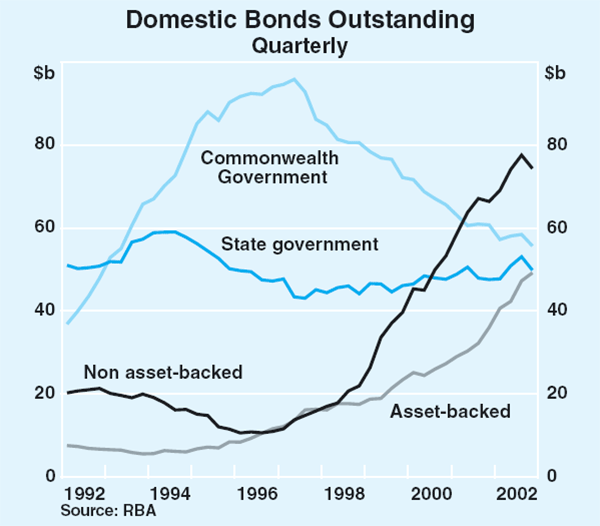
Australian banks initially responded to this surge in superannuation savings by offering retirement savings accounts – term deposits that would attract concessional tax rates if held until retirement age. These failed to catch on, however, largely because the rates of interest on offer failed to match the exceptional returns available from managed funds investing even a small proportion of their assets in the buoyant stock markets of the 1990s. Nor were managed funds burdened with the higher regulatory capital charges attached to banking business. So banks subsequently accelerated efforts to establish ‘wealth management’ arms and obtain a share of the fees and charges associated with funds management. At the same time, the adoption of securitisation techniques also opened up a way for banks to manufacture the types of products that might appeal to institutional investors such as superannuation funds. In essence, CRT markets provide a means of converting previously illiquid retail and corporate loan exposures into tradable assets – and in doing so, allow banks to recast themselves as financial intermediaries that ‘originate and distribute’ credit risk as well as ‘originate and hold’ it.
Securitisation has also been attractive from a financing perspective. As retail deposit growth slipped below credit growth throughout the 1990s – as households redirected a larger share of their financial assets to other intermediaries (see Graph 4) – banks were able to accelerate their mortgage lending without putting excessive pressure on their wholesale funding lines. By on-selling mortgages to an SPV, banks were able to fund some of the expansion in their housing lending through the capital markets. This access to securitisation markets is particularly beneficial for those regionally based banks with a small deposit base, but it is also valued by nationally operating banks that are willing to pay a premium over their own cost of funds to obtain access to another source of financing.
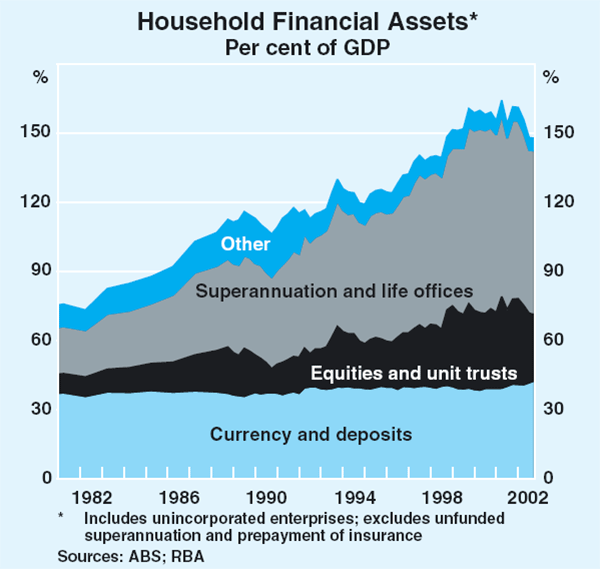
But the success of the asset-backed securities market has been something of a double-edged sword for Australian banks. On one side, securitisation has freed up economic and regulatory capital and provided banks with a diversified and flexible source of funding. On the other, securitisation has been instrumental in the rapid rise of non-bank originators for both traditional and non-conforming housing loans in Australia. By tapping the asset-backed securities market for funds, these non-bank mortgage originators have been able to compete aggressively with banks, squeezing the interest margins available from lending for housing. This wider participation in the asset-backed securities market means that banks now account for less than one-third of the underlying origination. Nevertheless, they still play a pivotal role in the asset-backed securities market through the provision of services such as liquidity support, swap arrangements and administrative services to SPVs holding non-bank-originated assets.
More generally, the development of a broadly based securitisation market is speeding up the process of disintermediation in Australia by encouraging corporate borrowers to bundle-up prospective income streams and tap the structured finance market for their financing in preference to borrowing from banks.
Implications for Financial Stability
The CRT markets pose some interesting issues from a financial stability perspective.[2] In principle, CRT markets would seem likely to promote stability. By allowing banks to disperse their credit risk more widely and to manage the risk on their own balance sheet more effectively, it seems reasonable to assume that they will be less vulnerable to the failure of individual firms or to reversals in the fortunes of particular sectors or regions – a perspective that seems to be borne out by the resilience of the international banking system following the downturn in the telecommunications sector and bankruptcy of major corporations such as Enron.
However, there are some potential concerns attached to the use of CRT instruments. For example, the transfer of credit risk may lessen the incentives of the originating institution to monitor the creditworthiness of the end-borrower; and the credit exposure may ultimately reside with an institutional investor such as a managed fund or an insurance company that lacks similar expertise in credit assessment. This information asymmetry gives rise to a related concern, that banks may use CRT markets to lay-off risk on those customers about which they have some emerging concerns well before these are readily apparent to the rest of the market. And if these concerns eventuate, wider dispersion of credit risk may also make any restructuring of a borrower's debt more difficult. For regulatory authorities, CRT markets also highlight the importance of having regulatory structures that are harmonised across financial sectors. Otherwise, there is the potential for regulatory arbitrage – a process by which credit risk is shifted to those parts of the financial system where the regulatory capital charges are lowest.
As far as credit derivatives are concerned, a prerequisite for smoothly functioning markets in times of stress is robust documentation – a requirement that has been tested from time to time as participants have debated the definition of a ‘credit event’. Although significant progress has been made in the design of standardised documents, it remains to be seen whether some of the existing uncertainties in contract design will act as a brake on further development of the market.
Finally, a key issue for central banks is transparency in CRT markets. Disclosure of CRT activities within financial accounts tends to be patchy at best, and the data available from statistical collections are less well developed than for more traditional instruments. In a fast-developing market with a potentially significant effect on the distribution of risks in financial markets, this lack of disclosure is a concern and one that central banks and regulatory authorities are seeking to address.
Appendix
Funded securitisation
In funded securitisation structures, loans, bonds or receivables are transferred from the originator's portfolio to a special-purpose vehicle (SPV) that holds them as collateral to back securities issued to investors. Flows of interest and principal on the collateral are used to pay interest and principal on the securities, although swaps and back-up lines of liquidity are often required to cover any cash flow mismatches between these payments flows. The pool of collateral may be static, or actively managed. In an actively managed pool, the portfolio manager will have the right to substitute some of the assets in the pool, subject to pre-defined criteria.
The investors are usually protected against the full impact of any credit loss within the underlying asset pool. In some structures, this is achieved by external credit enhancements such as letters of credit or guarantees from highly rated banks or insurance companies. This will ensure that some or all of the value is restored to the pool in the event of default. Mortgage insurance, for example, provides protection to holders of residential mortgage-backed securities.
Securitisation schemes also commonly build-in some form of structural enhancement to reallocate any losses among investors. This takes two main forms:
- Subordination arrangements in which an SPV issues several tranches of securities of varying seniority. Holders of the senior tranches (often AAA-rated) receive a lower rate of return but have priority of repayment. The most junior securities – those in the equity tranche – will absorb the first losses in the portfolio and are often unrated. Tranches between the equity and senior tranches are referred to as the mezzanine layer. A diagram of a representative securitisation structure is shown below (Graph A1).
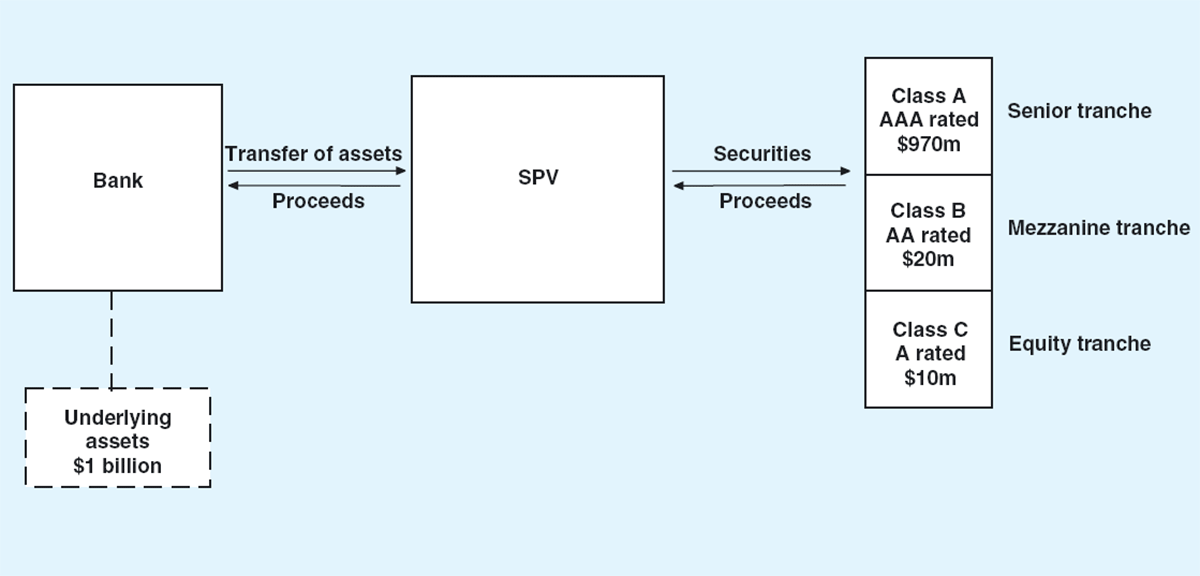
- Another approach is to establish ‘spread’ accounts that will absorb any credit losses ahead of the securities on issue. These first-loss accounts are funded by an initial deposit and/or by diverting excess servicing income generated by the assets that would otherwise flow to the originating institution.
Synthetic securitisation
In synthetic securitisations, only the credit risk associated with the assets is transferred to the SPV, rather than the underlying assets themselves. A synthetic securitisation structure has a number of characteristics:
- Instead of purchasing loans or bonds, the SPV sells protection on the credit risk attached to a portfolio of reference assets by entering into a portfolio CDS (or a number of single-name CDS), receiving premium income in return.
- The SPV covers some, or all, of the notional amount of risk on the CDS by issuing securities and investing the proceeds in low-risk collateral such as government bonds. The interest from the collateral pool, together with the premium income from the CDS, finances the payment of interest on the issued securities. In contrast to traditional securitisation structures, there is no recourse to the flows of interest and principal on the pool of reference assets.
- The SPV may cover a large proportion of the notional amount of risk on the reference assets by entering into a second CDS transaction, this time buying protection in the form of a ‘super senior’ portfolio CDS. Since this CDS will only be exercised after other investors in the scheme have absorbed any loss, the risk associated with it is minimal.
The following is a diagram of a representative synthetic structure (Graph A2).
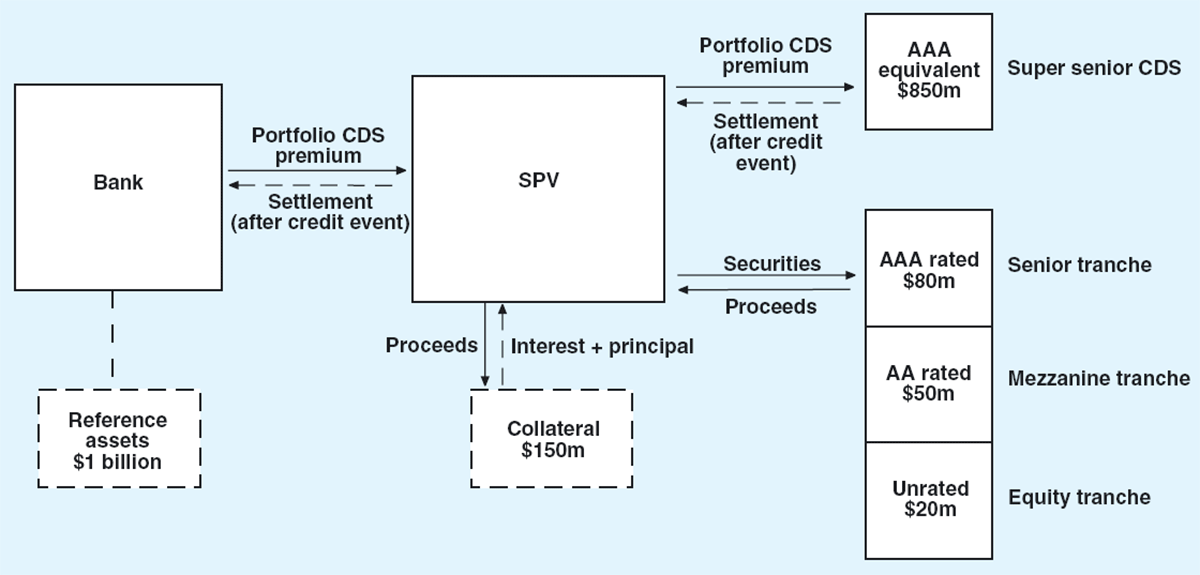
Footnotes
This article was prepared by Keith Hall and Erin Stuart of System Stability Department. [1]
These issues are explored in the report on ‘Credit Risk Transfer’ prepared by a Working Group of the Committee on the Global Financial System (CGFS). The RBA participated in this Working Group. This report was released in January 2003 and is available as CGFS Report No 20 on the website of the Bank for International Settlements <www.bis.org>. [2]